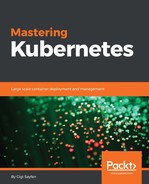In this chapter, we are going to look into Helm, the Kubernetes package manager. Every successful and non-trivial platform must have a good packaging system. Helm was developed by Deis (acquired by Microsoft 04/2017) and later contributed to the Kubernetes project directly. We will start by understanding the motivation for Helm, its architecture, and its components. Then, we'll get hands-on and see how to use Helm and its charts within Kubernetes. That includes finding, installing, customizing, deleting, and managing charts. Last but not least, we'll cover how to create your own charts and handle versioning, dependencies, and templating.
The topics we will cover are as follows:
- Understanding Helm
- Using Helm
- Creating your own charts
Kubernetes provides many ways to organize and orchestrate your containers at runtime, but it lacks a higher-level organization of grouping sets of images together. This is where Helm comes in. In this section, we'll go over the motivation for Helm, its architecture and components, and discuss what has changed in the transition from Helm Classic to Helm.
Helm provides support for several important use cases:
- Managing complexity
- Easy upgrades
- Simple sharing
- Safe rollbacks
Charts can describe even the most complex apps, provide repeatable application installation, and serve as a single point of authority. In-place upgrades and custom hooks allow for easy updates. It's simple to share charts that can be versioned and hosted on public or private servers. When you need to rollback recent upgrades, Helm provides a single command to rollback a cohesive set of changes to your infrastructure.
Helm is designed to perform the following:
- Create new charts from scratch
- Package charts into chart archive (
tgz) files - Interact with chart repositories where charts are stored
- Install and uninstall charts into an existing Kubernetes cluster
- Manage the release cycle of charts that have been installed with Helm
Helm uses a client-server architecture to achieve these goals
Helm has a server component that runs on your Kubernetes cluster and a client component that you run on a local machine.
The server is responsible for managing releases. It interacts with the Helm clients as well as the Kubernetes API server. Its main functions are as follows:
- Listening for incoming requests from the Helm client
- Combining a chart and configuration to build a release
- Installing charts into Kubernetes
- Tracking the subsequent release
- Upgrading and uninstalling charts by interacting with Kubernetes
